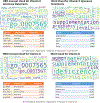Creating an ignorance-base: Exploring known unknowns in the scientific literature
- PMID: 37270143
- PMCID: PMC10528083
- DOI: 10.1016/j.jbi.2023.104405
Creating an ignorance-base: Exploring known unknowns in the scientific literature
Abstract
Background: Scientific discovery progresses by exploring new and uncharted territory. More specifically, it advances by a process of transforming unknown unknowns first into known unknowns, and then into knowns. Over the last few decades, researchers have developed many knowledge bases to capture and connect the knowns, which has enabled topic exploration and contextualization of experimental results. But recognizing the unknowns is also critical for finding the most pertinent questions and their answers. Prior work on known unknowns has sought to understand them, annotate them, and automate their identification. However, no knowledge-bases yet exist to capture these unknowns, and little work has focused on how scientists might use them to trace a given topic or experimental result in search of open questions and new avenues for exploration. We show here that a knowledge base of unknowns can be connected to ontologically grounded biomedical knowledge to accelerate research in the field of prenatal nutrition.
Results: We present the first ignorance-base, a knowledge-base created by combining classifiers to recognize ignorance statements (statements of missing or incomplete knowledge that imply a goal for knowledge) and biomedical concepts over the prenatal nutrition literature. This knowledge-base places biomedical concepts mentioned in the literature in context with the ignorance statements authors have made about them. Using our system, researchers interested in the topic of vitamin D and prenatal health were able to uncover three new avenues for exploration (immune system, respiratory system, and brain development) by searching for concepts enriched in ignorance statements. These were buried among the many standard enriched concepts. Additionally, we used the ignorance-base to enrich concepts connected to a gene list associated with vitamin D and spontaneous preterm birth and found an emerging topic of study (brain development) in an implied field (neuroscience). The researchers could look to the field of neuroscience for potential answers to the ignorance statements.
Conclusion: Our goal is to help students, researchers, funders, and publishers better understand the state of our collective scientific ignorance (known unknowns) in order to help accelerate research through the continued illumination of and focus on the known unknowns and their respective goals for scientific knowledge.
Keywords: Epistemology; Information extraction; Knowledge representation; Knowledge-base; Natural language processing.
Copyright © 2023 The Author(s). Published by Elsevier Inc. All rights reserved.
Conflict of interest statement
Declaration of competing interest The authors declare that they have no known competing financial interests or personal relationships that could have appeared to influence the work reported in this paper.
Figures














References
-
- Firestein S, Ignorance: How it drives science, OUP, USA, 2012.
-
- Kuhn TS, The structure of scientific revolutions, [2d ed., enl Edition, International encyclopedia of unified science. Foundations of the unity of science, v. 2, no. 2, University of Chicago Press, Chicago, 1970.
-
- O’leary Z, The essential guide to doing research, Sage, Great Britain, 2004.
Publication types
MeSH terms
Substances
Grants and funding
LinkOut - more resources
Full Text Sources

